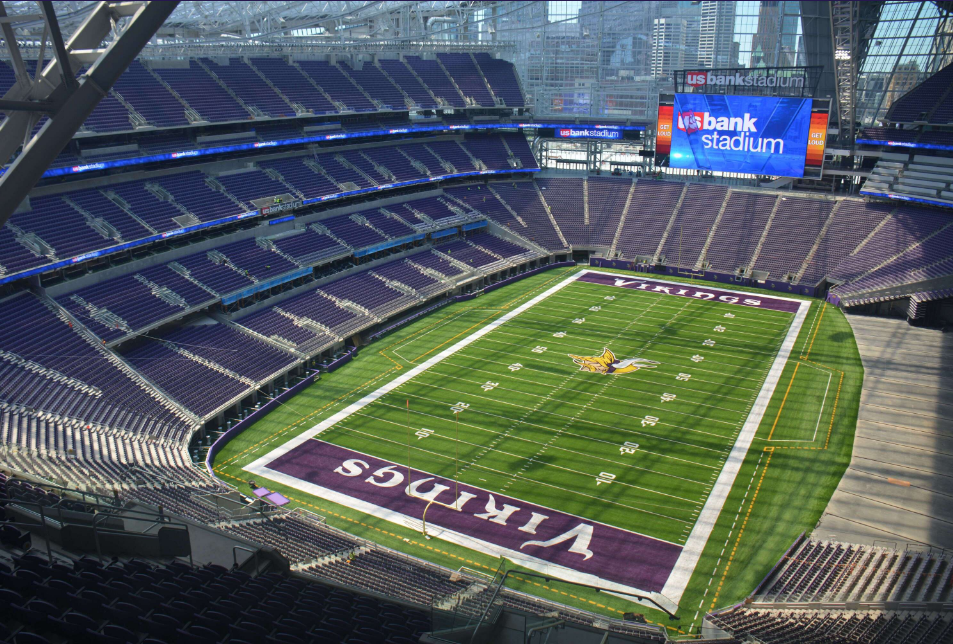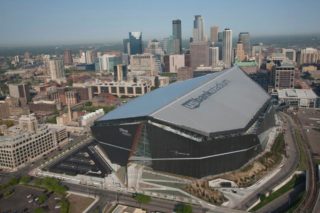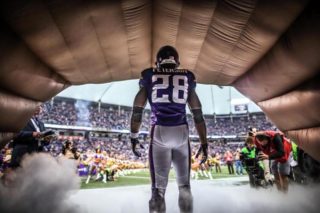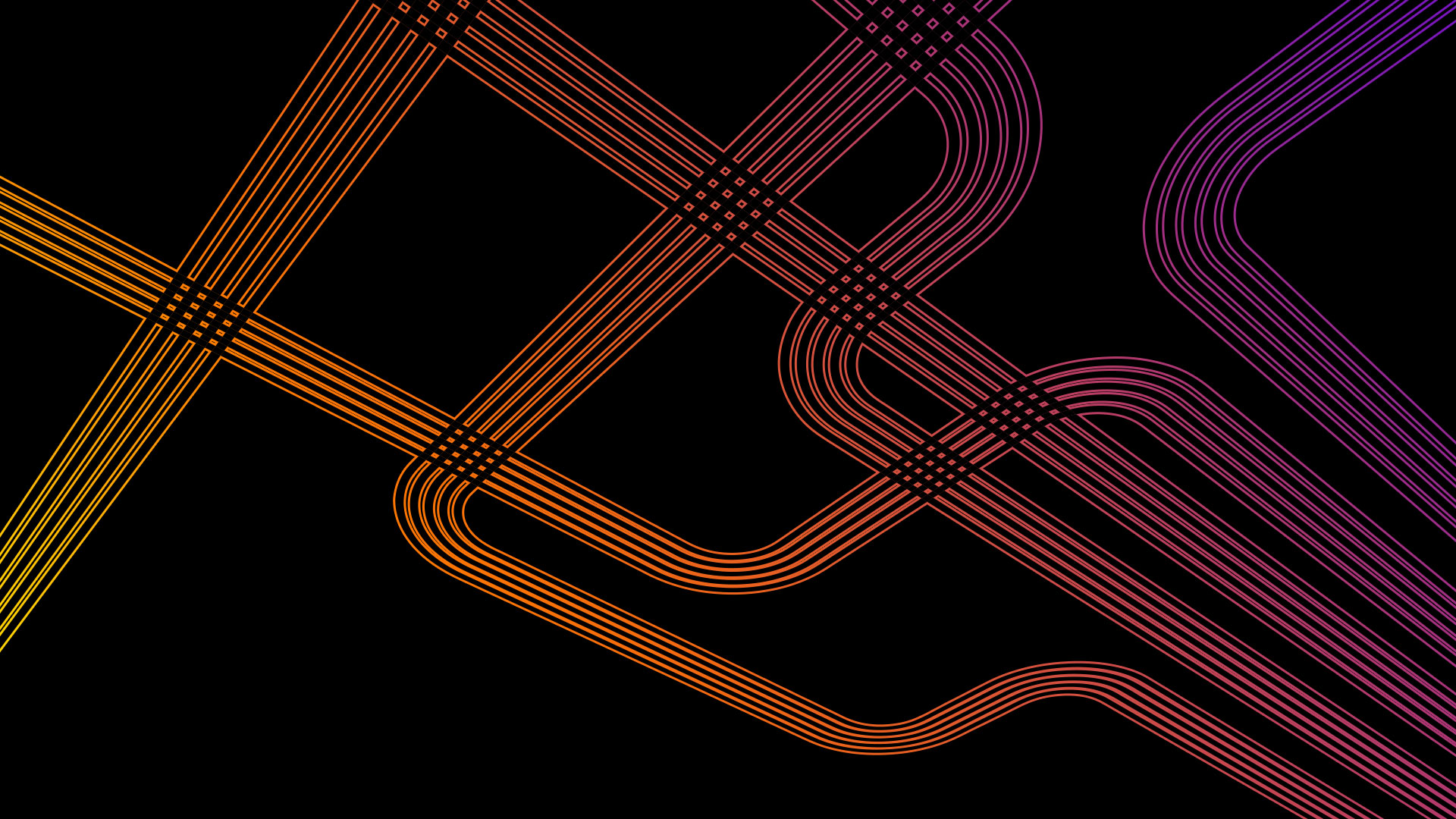The Minnesota Vikings will become the latest football franchise to play in new digs when they officially open U.S. Bank Stadium’s pearly purple gates against the arch-rival Green Bay Packers on September 18.
The 66,200-seat stadium is already towering over the Minneapolis skyline and is five weeks away from hosting its opening event in a Premier League match between Chelsea and A.C. Milan. The official ribbon-cutting ceremony is July 22.
Construction of the stadium—which first began in April 2014—is basically a few screws away from completion. The building could not have been erected without the help of 3M, another Minnesota institution and official science partner of the Vikings who contributed with more than 50 of their products, including graphic films and architectural finishes, throughout the stadium.
Attendees will be able to see 3M technology from all parts of the cavernous abode that’s twice the size of the since-imploded Metrodome. Football fans may best remember the Vikings’ outdated stadium as the surreal scene to a mountain of snow forcing its roof to catastrophically collapse hours prior to a game in 2010.
Since winter has no intentions of ever leaving Minnesota, U.S. Bank Stadium will have a clear, lightweight and self-cleaning roof. 3M introduced their industry-leading science-based technology through Ethylene Tetrafluoroethylene polymer (ETFE), a clear, lightweight film used on the roof panels.
Most NFL prognosticators are predicting that the Adrian Peterson-led Vikings and its prodigious defense will advance deep in the postseason during their inaugural year playing in a $1.1 billion state-of-the-art, multi-use facility.
[a]listdaily caught up with Nick Harris, 3M’s senior sponsorship and events manager and Jeff Anderson, the Vikings’ executive director of communications, to discuss some of the science and marketing behind Minnesota’s newly minted marvel.

What are some ways 3M applied science in the construction of U.S. Bank Stadium?
Harris: Vikings fans will be surrounded by 3M technology—from the graphic films covering walls and DI-NOC architectural finishes in concessions, to the unique film that was used to create the clear, lightweight and self-cleaning roof—the first sports facility in the US with this kind of roof. 3M fire barrier products will also protect the stadium for years to come. Even during construction, 3M technology helped builders stay safe through personal safety products like respirators, eye wear, helmets and hearing protection.
How does the science behind ETFE and the clear, self-cleaning roof work?
Harris: The stadium will be covered by high-performance film, extruded from 3M Dyneon ETFE. The product lets light in, is lighter than glass, and is more cost-effective than retractable alternatives. The stadium’s 248,000-square-foot roof and facade is covered by 75 three-layer ETFE film cushions, making U.S. Bank Stadium the largest ETFE film project in the US. Some of the individually air-filled cushions are more than 1,200 square feet long and about 32-feet wide. The top film is printed with a geometric pattern, which scatters the sunlight and prevents a greenhouse effect in summer. In winter, the film roof protects the interior from the cold outside temperatures. The film cushions allow 95 percent of daylight to pass through, but their weight is only about five percent of the weight of glass. As a result, the supporting steel structure is light and slender, offering spectators a premium view of the playing field.
Open-air football stadiums are not often a viable option in northern climates. The Dallas-based firm HKS Architects chose the ETFE film cushion technology, which is already widespread in Europe and Asia, to enable year-round use for a variety of events. The design lowered construction costs by around $100 million compared to a retractable roof. Since the Metrodome’s roof collapsed in 2010 under the weight of a 17-inch snowstorm, architects and roof planners paid particular attention to the load-bearing capability under heavy snow falls. Compared to other roofing membranes, ETFE films feature superior values for tear strength, resistance to tear propagation and puncture resistance—which let the air-filled cushions easily cope with highly concentrated impact loads like hail. Their use in northern Europe and the Alps prove their winter compatibility in areas with heavy snowfall. U.S. Bank’s asymmetric roof inclines more toward the north to fend off the snow. The films are so smooth, snow can hardly get a grip, sliding off in an almost controlled manner. A heavy rain shower is enough to clean it.

Why did the Vikings choose to form a 20-year partnership with U.S. Bank for the naming rights?
Anderson: U.S. Bank is a prominent and respected Minnesota institution that carries a deep commitment to the economic and social well-being of the state. We are proud to partner with them on both U.S. Bank Stadium and the Places to Play program, which will benefit communities throughout Minnesota by further creating safe, quality and accessible places for kids to be kids.
More than fifty 3M products were used during the design and building of the stadium. Will you be highlighting any of this prior to the start of the season as part of your marketing plan?
Harris: We’re so proud of our involvement with the Vikings and our partnership to help create the most advanced US sports facility. Our customers are already familiar with many of the products in the stadium, but having them in one location gives us a great platform to share and spark further conversation.
How will the 3M-branded first aid stations work? Will it help fans cope with devastating, last-second losses?
Harris: We predict an undefeated season at home for the Vikings in their new stadium! The ACE brand by 3M will be the preferred supplier of first aid stations in the stadium, and we plan to provide bandages, wraps, ice packs and an array of other first aid products that can help fans who need assistance.

A new $1.1 billion stadium offers a tremendous opportunity to further build a team’s brand. What is the Vikings’ integrated marketing plan around U.S. Bank Stadium heading into the season?
Anderson: From day one with this project the focus for the team has been about the fan experience. U.S. Bank Stadium will offer an unmatched fan experience and will open unique ways in which we can further develop our relationship with Vikings fans. We are incredibly excited about our new opportunity to speak to fans on all levels, from advertising and commercials, to in-stadium production and experience, to regional marketing events and activities. We now have the ability to reach fans in so many different ways all over the North.
3M and the Vikings are both Minnesota staples in the community, and that marriage makes plenty of sense. What are the main factors for 3M identifying other potential sponsorship partners?
Harris: The partnership with the Vikings is a great opportunity to share stories that highlight 3M science applied to life with a broader audience of sports fans around the country and around the world. Aside from the opportunities it brings us, we are just plain proud of our Minnesota heritage and are excited about the home-team partnership. As for other sponsorships, we look very carefully at the business value and alignment with our business goals before moving forward with any sponsorship decision.
How do the Vikings plan on leveraging its own brand, and the 3M brand, over the lifetime of the partnership?
Anderson: As a strong Minnesota brand, 3M is synonymous with science and innovation. Certainly those characteristics go hand in hand with enhancing the fan experience and growing the passion for football and the Vikings, so we look forward to working with 3M on those possibilities. Additionally, we always want to help our partners leverage the Vikings brand. We work with each partner individually to find what works best for them and fits their goals.
Follow Manouk Akopyan on Twitter @Manouk_Akopyan
https://www.youtube.com/watch?v=L3x1sbhWvMo

